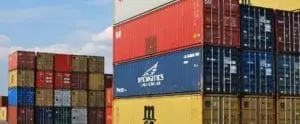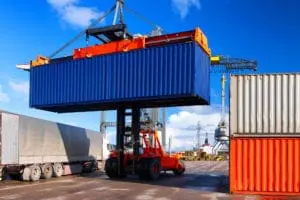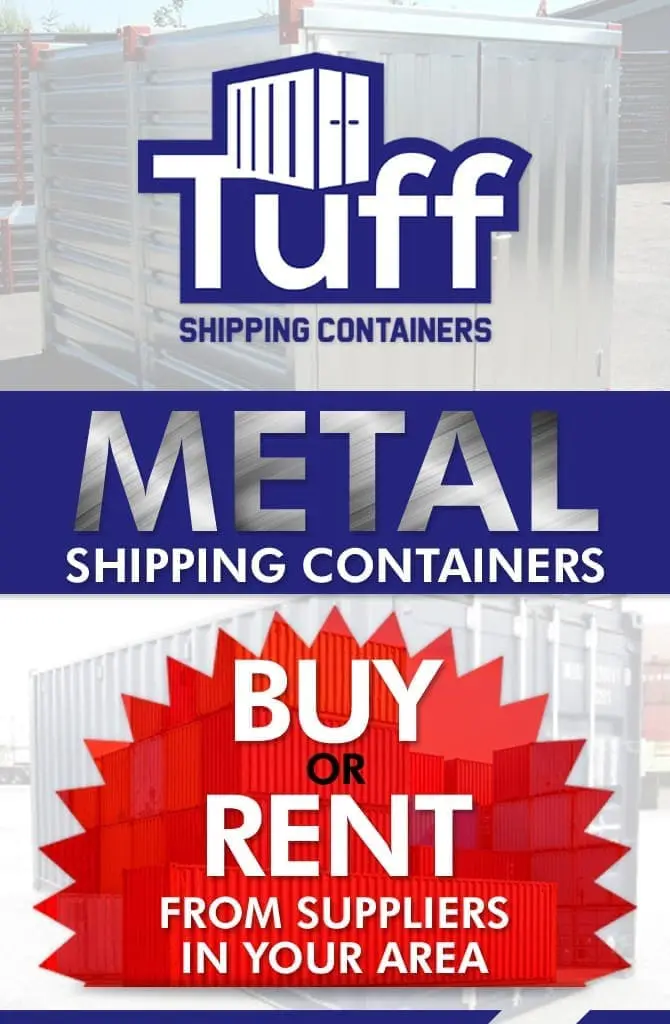Small & Large Steel Storage Containers | Choose A Metal Conex Box Size
Find Any Size Metal Storage or Steel Shipping Containers in Your Area
SMALL SHIPPING CONTAINERS
Used shipping and storage containers ranges from 6’ to 10’.
MEDIUM SHIPPING CONTAINERS
Mid-sized metal storage containers in sizes between 20’ to 40’.
LARGE SHIPPING CONTAINERS
Large steel shipping containers starting at 45’ and bigger.
Standardization of Shipping Container Sizes
The International Organization for Standardization governs sizes for shipping containers. The relevant ISO standards for the size and dimension requirements of containers are ISO 668 and 1496.
This standardization means that shipping containers are only brought into circulation when they have been manufactured and tested against these standards. This ensures that goods are transported safely, either by ship, truck, or rail.
Shipping Container Sizes
Let’s take a look now at the different sizes of shipping containers that are available. The type and weight of the cargo you wish to transport may influence the size of the shipping container you choose. If what you’re looking for is a storage solution, this will also have an impact on your decision.
| 8' (ft) Container | External Dimensions: 8 ft (2.44 m) L x 7 ft 2 in (2.2 m) W x 7 ft 4 in (2.26 m) H | Internal Dimensions: 7 ft 6 in (2.29 m) L x 6 ft 11 in (2.11 m) W x 6 ft 9 in (2.06 m) H | Door Opening: 6 ft 10 in (2.1 m) W x 6 ft 4 in (1.95 m) H | Cubic Volume: 351 ft3 (cubic ft) 9.95 m3 (cubic meters) | Empty Weight: 2100 lbs. (950 kg) | Load Capacity: 11,143 lbs. (5050 kg) | Max Gross Weight: 13,243 lbs. (6000 kg) |
| 10' (ft) Container | External Dimensions: 9 ft 10 in (3 m) L x 8 ft (2.438 m) W x 8 ft 6 in (2.591 m) H | Internal Dimensions: 9 ft 3 in (2.84 m) L x 7 ft 8 in (2.35 m) W x 7 ft 10 in (2.39 m) H | Door Opening: 7 ft 8 in (2.34 m) W x 7 ft 5 in (2.28 m) H | Cubic Volume: 561 ft3 (cubic ft) 15.1 m3 (cubic meters) | Empty Weight: 2870 lbs. (1300 kg) | Load Capacity: 19,530 lbs. (8860 kg) | Max Gross Weight: 22,400 lbs. (10,160 kg) |
| 20' (ft) Container | External Dimensions: 19 ft 10.5 in (6.058 m) L x 8 ft (2.438 m) W x 8 ft 6 in (2.591 m) H | Internal Dimensions: 19 ft 3 in (5.867 m) L x 7 ft 8 19⁄32 in (2.352 m) W x 7 ft 9 57⁄64 in (2.385 m) H | Door Opening: 7 ft 8 1⁄8 in (2.340 m) W x 7 ft 5 3⁄4 in (2.280 m) H | Cubic Volume: 1,169 ft3 (cubic ft) 33.1 m3 (cubic meters) | Empty Weight: 4850 lbs. (2200 kg) | Load Capacity: 61,289 lbs. (27,800 kg) | Max Gross Weight: 66,139 lbs. (30,000 kg) |
| 40' (ft) Container | External Dimensions: 40 ft (12.192 m) L x 8 ft (2.438 m) W x 8 ft 6 in (2.591 m) H | Internal Dimensions: 39 ft 5 45⁄64 in (12.032 m) L x 7 ft 8 19⁄32 in (2.352 m) W x 7 ft 9 57⁄64 in (2.385 m) H | Door Opening: 7 ft 8 1⁄8 in (2.340 m) W x 7 ft 5 3⁄4 in (2.280 m) H | Cubic Volume: 2,385 ft3 (cubic ft) 67.5 m3 (cubic meters) | Empty Weight: 8380 lbs. (3800 kg) | Load Capacity: 57,759 lbs. (26,199 kg) | Max Gross Weight: 66,139 lbs. (30,000 kg) |
| 40' (ft) High-Cube Container | External Dimensions: 40 ft (12.192 m) L x 8 ft (2.438 m) W x 9 ft 6 in (2.896 m) H | Internal Dimensions: 39 ft 4 in (11.989 m) L x 7 ft 7 in (2.311 m) W x 8 ft 9 in (2.667 m) H | Door Opening: 7 ft 6 in (2.286 m) W x 8 ft 5 in (2.565 m) H | Cubic Volume: 2,660 ft3 (cubic ft) 75.3 m3 (cubic meters) | Empty Weight: 8598 lbs. (3900 kg) | Load Capacity: 58,598 lbs. (26,580 kg) | Max Gross Weight: 68,008 lbs. (30,848 kg) |
| 45' (ft) High-Cube Container | External Dimensions: 45 ft (13.716 m) L x 8 ft (2.438 m) W x 9 ft 6 in (2.896 m) H | Internal Dimensions: 44 ft 4 in (13.513 m) L x 7 ft 8 19⁄32 in (2.352 m) W x 8 ft 9 15⁄16 in (2.691 m) H | Door Opening: 7 ft 8 1⁄8 in (2.340 m) W x 8 ft 5 49⁄64 in (2.585 m) H | Cubic Volume: 3,040 ft3 (cubic ft) 86.1 m3 (cubic meters) | Empty Weight: 10,580 lbs. (4800 kg) | Load Capacity: 55,559 lbs. (25,201 kg) | Max Gross Weight: 66,139 lbs. (30,000 kg) |
| 48' (ft) Container | External Dimensions: 48 ft (14.630 m) L x 8 ft 6 in (2.591 m) W x 9 ft 6 in (2.896 m) H | Internal Dimensions: 47 ft 6 in (14.478 m) L x 8 ft 2 in (2.489 m) W x 8 ft 11 in (2.718 m) H | Door Opening: 8 ft 2 in (2.489 m) W x 8 ft 10 in (2.692 m) H | Cubic Volume: 3,454 ft3 (cubic ft) 97.8 m3 (cubic meters) | Empty Weight: 10,850 lbs. (4920 kg) | Load Capacity: 56,350 lbs. (25,560 kg) | Max Gross Weight: 67,200 lbs. (30,500 kg) |
| 53' (ft) Container | External Dimensions: 53 ft (16.154 m) L x 8 ft 6 in (2.591 m) W x 9 ft 6 in (2.896 m) H | Internal Dimensions: 52 ft 6 in (16.002 m) L x 8 ft 2 in (2.489 m) W x 8 ft 11 in (2.718 m) H | Door Opening: 8 ft 2 in (2.489 m) W x 8 ft 10 in (2.692 m) H | Cubic Volume: 3,830 ft3 (cubic ft) 108.5 m3 (cubic meters) | Empty Weight: 11,110 lbs. (5040 kg) | Load Capacity: 56,090 lbs. (25,440 kg) | Max Gross Weight: 67,200 lbs. (30,500 kg) |
 Small Shipping Containers – 6ft, 8ft, 10ft, 16 ft
Small Shipping Containers – 6ft, 8ft, 10ft, 16 ft
Small shipping containers are available ranging from 6-10 feet in length with a weight capacity of between 710kg and 1300kg. Sometimes space is at a premium, and a small container is what a business requires.
It’s possible to buy or rent these containers individually, or as a set, which would be securely fastened together using ties. They can offer a flexible storage solution, for domestic or business use.
The 6 ft size and the 8 ft containers are the most popular and cost-effective options. Businesses can use them for general equipment storage or archiving. The 10 ft option and 16ft containers are popular for shipping and storage applications, including storage of site equipment on construction sites.
20 ft – 30 ft Standard Shipping Containers


This size shipping container represents good value for money and is also a versatile option for storage. It’s advisable to rent shipping containers if the storage need is short or medium term, rather than purchasing a unit outright.
- External measurements: 6.06 meters/2.44m/2.59m [20’/8’/8’6″]
- Internal measurements: 5.87 meters /2.33m/2.35m [19’3″/7’8″/7’9″]
- Ground area: 13.93m2 [150 square feet]
- Container Volume: 32.85m3 [1160 cubic feet]
- Max weight: 2230 kilograms
A standard shipping container is completely airtight and doesn’t have any cooling or ventilation system. These containers are also known as dry vans or dry shipping containers.
The dimensions of a 20 ft standard shipping container in meters are 2.44 meters wide, 2.59 meters high, and 6.06 meters long. They can carry up to 10 standard pallets and a maximum weight of 30,480 kg.
40 FT Shipping Containers


Offering twice the capacity of a 20 ft container, 40 ft metal containers generally only cost 15-25% more. This is therefore the most cost-efficient container for transporting goods by ship. Metal shipping containers are made of highly non-corrosive material, making them able to withstand long periods of time at sea without being damaged.
- External measurements: 12.19meters /2.44m/2.59m [40’/8’/8’6″]
- Internal measurements: 12.00meters /2.33m/2.35m [39’5″/7’8″/7’9″]
- Ground area: 28.33m2 [305sq. ft.]
- Container Volume: 66.83m3 [2360 cubic feet]
- Max weight: 3950 kilograms
The dimensions of a 40 ft standard shipping container are 2.44 meters wide, 2.59 meters high, and 12.19 meters long. They can carry a maximum weight of 30,480 kg. This is the same weight capacity as the 20 ft container, so haulers tend to transport bulkier but lighter items in 40 ft containers.
45 ft Shipping Containers


The additional space available gives the potential advantage of lower transport costs per unit. Therefore the 45 ft container is an efficient option for cargo transportation.
The width and height dimensions are the same as the 20, 30, and 40 ft containers, but the length is 13.71 meters. The weight capacity for the 45 ft container is similar to the 40 ft container.
High Cube Shipping Containers
High cube shipping containers come in the standard sizes as listed above, but have an extra foot of overhead room. This gives additional volume for storage or for the transportation of larger equipment or items.
These containers are often used for shipping of tall loads, including site equipment such as diggers or other heavy-duty machinery. As well as being a foot taller than standard containers, they’re also 6 inches wider, giving that extra bit of volume for your storage or transportation needs.
Ventilated Shipping Containers


They are sometimes known as “coffee containers”, as coffee is one of the main products transported in ventilated containers. The interior dimensions of a 20 ft ventilated shipping container are 2.35 meters wide, 2.4 meters high, and 5.9 meters long. The maximum payload is 21,727 kg.
Refrigerated Shipping Containers
Also known as reefers, refrigerated shipping containers can maintain an internal temperature of between -25° and +25°. Some containers are able to maintain temperatures as low as -60°.
It’s necessary to connect these containers to an external power supply to maintain the required temperature. This can either be via the generator on the ship or connected to the power supply at the port.
These kinds of containers are most commonly used to transport fresh and frozen food and also medicines and other pharmaceutical products. It’s important to store and transport these items at a constant temperature.
Refrigerated shipping containers come in 20 ft and 40 ft sizes. The internal dimensions are slightly smaller than standard containers, as the walls are thicker to maintain insulation.
Flat Rack Shipping Containers
These containers are designed to transport cargo which does not fit into a standard container. They are constructed of metal plates which fit either the standard 20 ft or 40 ft structure, but have no roof or top and have collapsible sides.
This means it’s possible to load awkwardly shaped goods via the top or side of the container. This can be a useful option for transporting over-sized items such as heavy machinery or building supplies. Often it’s necessary for a crane to load these items.
Special care is needed in the loading and lashing of this kind of cargo, to protect from damage which may be caused by severe weather conditions at sea. It’s also important to provide special handling instructions to the freight forwarder.
Flat rack shipping containers come in 20 ft and 40 ft sizes. They have a much higher weight capacity than standard containers – 42,000 kg for a 20 ft and 38,750 kg for a 40 ft flat rack container.
Open Top Shipping Containers
Open top containers come in the 20 ft and 40 ft sizes. Exporters use them to transport similar categories of goods to flat rack shipping containers. They do not have a roof, but they do have sides, so they can transport items with irregular heights which would not fit into a high cube container.
It’s worth noting that the maximum load for a 20 ft open top container is 28 metric tons, while for a 40 ft open top container it is only 20 metric tons. Also, the opening for loading is slightly smaller than the interior capacity. It’s necessary to consider this when planning load capacity.
Rent or Buy Shipping Containers of Any Size
You should now be fully informed on the various shipping container sizes available and the different types and shapes too. Now is the time to choose which type of shipping containers is most suitable for your business needs, whether those are storage or transportation requirements.
Don’t hesitate to contact us to discuss your requirements further. We can provide quotations for both the sale and rental of containers to suit all your business needs.
Steel Container Size Overview
Shipping containers come in a wide variety of shapes and sizes. Here’s everything you need to know about the various shipping container sizes available.
There are currently estimated to be 17 million shipping containers in circulation globally, making around 200 million trips per year.
There are many different types, sizes, and shapes of shipping containers available. Depending on the type of cargo, importers and exporters use different shipping container sizes. Some businesses also use shipping containers for storage.
Whether you’re looking for a solution for storage or transportation, it’s crucial to understand the various sizes of shipping container sizes and shapes that are available.
History of Shipping Container Dimensions
It might surprise you to learn that shipping containers have only been in use for around 60 years. Before this time, there was no standard way of transporting goods by ship. Workers often had to dismantle or separate cargo before they could load it onto the ships. This resulted in wasted time, labor, and money.
In the mid-20th century, a truck hauler named Malcolm McLean from North Carolina developed a system of loading merchandise from factories and warehouses into containers. Cranes could lift these containers directly onto ships or trucks without workers having to unpack them.
The next step was to standardize the dimensions of shipping containers. This made them easier to handle, making the whole process much more time-efficient and cost-effective.
The containerization of shipping has had a major impact on world trade. It has enabled manufacturers to transport goods efficiently across long distances to a wide range of global markets.
 Small Shipping Containers – 6ft, 8ft, 10ft, 16 ft
Small Shipping Containers – 6ft, 8ft, 10ft, 16 ft